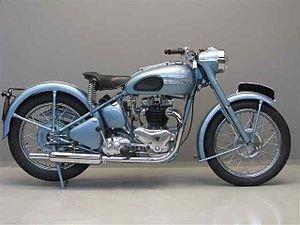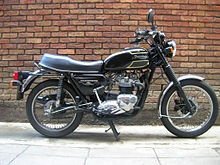Triumph Engineering Co Ltd was a British motorcycle manufacturing company, based originally in Coventry and then in Meriden. A new company, Triumph Motorcycles Ltd, based in Hinckley, gained the name rights after the end of the company in the 1980s and is now one of the world's major motorcycle manufacturers.

The Triumph Triples are a family of modern DOHC inline three-cylinder motorcycle engines made from 1990 onwards by the Triumph Motorcycle Company at their Hinckley, Leicestershire factory. The inspiration for the later triples was the pushrod Triumph Trident, produced from 1968 to 1974 at the Triumph factory at Meriden Works.

The Triumph Trident and BSA Rocket 3 was a technically advanced, high-performance roadster motorcycle made by Triumph Engineering and BSA from 1968 to 1975, and sold under both the Triumph and BSA marques. Alongside the Honda CB750, and later the two-stroke Kawasaki triples, it brought a new level of sophistication to street motorcycles, marking the beginning of the superbike era. The Honda CB750 overshadowed the Trident to be remembered as the 'first superbike', in spite of the Triumph Trident actually debuting before the Honda by a few weeks.

The Triumph Bonneville is a standard motorcycle featuring a parallel-twin four-stroke engine and manufactured in three generations over three separate production runs.

Associated Motor Cycles (AMC) was a British motorcycle manufacturer founded by the Collier brothers as a parent company for the Matchless and AJS motorcycle companies. It later absorbed Francis-Barnett, James, and Norton before incorporation into Norton-Villiers. Henry Herbert Collier founded Matchless as a cycle company in 1878. His sons Henry (Harry) and Charles (Charlie) joined him and the name was changed to H. Collier & Sons.
Norton Villiers Triumph (NVT) was a British motorcycle manufacturer, formed by the British government to continue the UK motorcycling industry, until the company's ultimate demise.

The Norton Commando is a British Norton-Villiers motorcycle with an OHV pre-unit parallel-twin engine, produced by the Norton Motorcycle company from 1967 until 1977. Initially having a nominal 750 cc displacement, actually 745 cc (45.5 cu in), in 1973 it became an 850 cc, actually 828 cc (50.5 cu in). It had a hemi-type head, similar to all OHV Norton engines since the early 1920s.

Edward Turner was an English motorcycle designer. He was born in Camberwell in the London Borough of Southwark, on the day King Edward VII was proclaimed King. In 1915, Turner had his first ride on a motorcycle, a Light Tourist New Imperial.
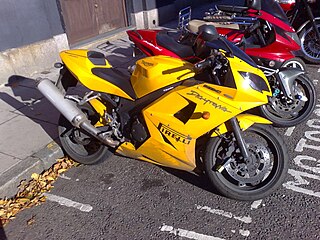
The Triumph Daytona 600 is a name given to two different motorcycles.
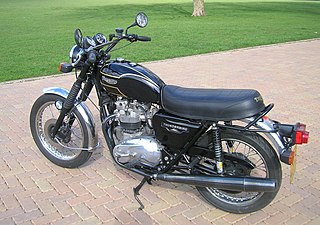
The Triumph TR65 Thunderbird is a motorcycle made by the Triumph worker's co-operative at the Meriden factory from 1981 to 1983. The TR65 was a reintroduction of the Triumph Thunderbird model name first used on the original 6T Thunderbird of 1949. A short stroke model, the Daytona 600 was designed in 1983 but not produced.

The Triumph TSX was a British motorcycle credited by the factory as being designed in 1981–1982 by Wayne Moulton, president of Triumph Motorcycles America(TMA), the factory's American arm. This is the only instance of Triumph's signature twin cylinder models being designed by an American.
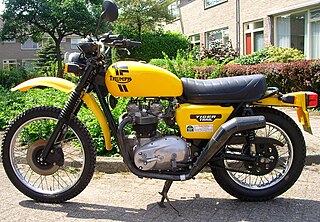
The Triumph Tiger Trail was a motorcycle model manufactured by Triumph Motorcycles at the Meriden factory. The Tiger Trail was made from 1981 to 1982 in both 750 cc (TR7T) and 650 cc (TR65T) capacities, and under 180 examples were built. Emission regulations precluded export to the USA but otherwise the model was available to all Triumph's other markets particularly in many British Commonwealth nations and western Europe.
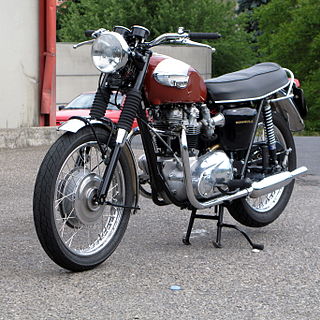
The Triumph Bonneville T120 is a motorcycle originally made by Triumph Engineering from 1959 to 1975. It was the first model of the Bonneville series, which was continued by Triumph Motorcycles Ltd. The T120 was discontinued in favour of the larger 750 cc T140 in the early 1970s.

The TR6 Trophy is a motorcycle that was made by Triumph, in Meriden, from 1956 to 1973, when it was replaced by the five-speed 750-cc Triumph Tiger TR7V. During this time, it was a successful model, particularly in the US. The competition variant, popularly known as the "desert sled", won numerous competitions throughout the late 1950s and 1960s. Steve McQueen's fondness for the model is well known, as is his participation in the 1964 ISDT on a TR6 Trophy.
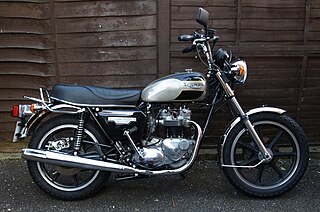
The Triumph Bonneville T140 is a standard motorcycle with a 750 cc (46 cu in) capacity engine that was designed and built by Triumph Engineering at Meriden near Coventry.
Brian Jones was a motorcycle designer and engineer born in Gloucester, United Kingdom in 1928. Notable for his contribution to the original design of the Triumph Bonneville, he died in Coventry, on 4 March 2001.

The Triumph Twenty One is a standard motorcycle made by Triumph Engineering Co Ltd in Coventry. The Model Twenty One was the first of the Triumph unit construction twin cylinder motorcycles. Rebranded as the Triumph 3TA in 1959 it continued in production until 1966 when it was survived by the Triumph T90, its sports version.
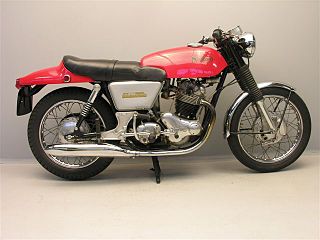
The isolastic frame, designated by Norton as GlideRide, used a system of engine-to-frame mountings incorporating rubber bushes to isolate the vibration of the vertical twin engine from the frame and rider. The isolastic frame was developed for use with the Commando inclined engine, whilst the Featherbed frame continued in production for the Mercury with a softer-specification 650 cc vertical-engine until 1970.
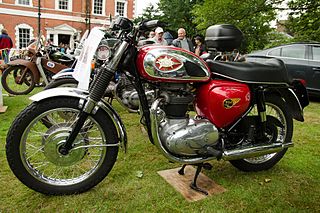
The BSA unit twins were a range of unit construction twin-cylinder motorcycles made by the Birmingham Small Arms Company (BSA) and aimed at the US market. A range of 500 cc (31 cu in), 650 cc (40 cu in) and 750 cc (46 cu in) twins were produced between 1962 and 1972, but they were really developments of the older pre-unit A7/A10 model range with less weight. The engines had a reputation for vibration, but acceleration was good for the time, to a top speed of 100 miles per hour (160 km/h).

The BSA B25 was a series of 250 cc (15 cu in) unit construction single-cylinder OHV four-stroke motorcycles made by the Birmingham Small Arms Company. Developed from the BSA C15, the machines were produced between 1967 and 1971. The B25 was the fastest British production 250.
